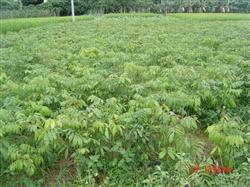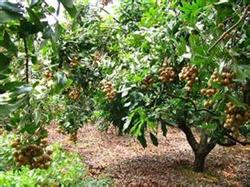Control of white moth wax cicada and wax scale in longan orchard

White moth wax cicada and wax powder scale belong to Homoptera, the former belongs to Cicadellidae, the latter belongs to powder scale family, which mainly harms fruit trees such as citrus, longan, litchi and mango. In the past, the population of this pest was often controlled by a large number of natural enemies and rarely reached the level of economic loss. In recent years, due to the extensive management of some longan orchards in our region, excessive spraying of pesticides to kill natural enemies, and changes in the climate and environment system, the harm of the two kinds of pests has become more serious, seriously affecting the commodity quality of longan fruits and causing economic losses to fruit growers. First, the characteristics of harm. The symptoms of longan harmed by white moth wax cicada and wax powder scale are similar. Its adults and nymphs use piercing mouthparts to suck the leaves, tender shoots, flower spikes and fruit juices of longan. The adults and nymphs of the two kinds of pests are covered with wax powder. because the wax is not hydrophilic, it is difficult for pesticides to touch the insect body, and the pests have strong drug avoidance and resistance. When harming the stalk and fruit, the two insects stick wax powder on the pedicel or fruit, and it is difficult to remove it even if Rain Water scours it. The insect body will excrete honeydew and induce soot disease, which not only reduces the size of the injured fruit, but also damages the appearance of the fruit. The flesh also smells fishy and unedible; the young leaves, spikes and branches withered or the new shoots of young buds are deformed and twisted, which hinders the growth and seriously affects the tree. Second, life habits. The white moth wax cicada has two generations a year, the first generation nymphs occur from March to April, and the second generation from July to August, overwintering as adults in dense branches and leaves. The first generation nymphs flourished in early April, the second generation in mid-May, the third generation in mid-July, the fourth generation in early September, the fifth generation in early October and the sixth generation in mid-November. Overwintering as adults and nymphs in tree trunks, branches, cracks, rolled leaves or ant nests. The two kinds of pests began to move when the weather turned warm from February to March of the following year, and both adults and nymphs were clustered; the white moth wax cicada was more serious in summer and autumn when it was hot and humid, while the wax powder scale had the highest population density from April to May and October to November. The natural reproduction ability of the two kinds of pests is strong, especially the wax powder scale, under the natural conditions, the occurrence of males is rare, parthenogenesis is basic, there are 200-500 eggs per oocyst, and the hatching rate is high, both of them are easy to cause disasters, and can parasitize many kinds of plants at the same time. The migration ability of adults of white moth and wax cicada is very strong. Therefore, it is extremely difficult and harmful to wipe it out completely. Agricultural control measures 1. Agricultural control: strengthen the cultivation and management of orchards, combined with longan thinning flowers and fruits in spring and pruning after fruit harvest to spring shoots before sprouting, cut off overdense branches and insect branches, concentrate and burn them, so that the crown is ventilated and transparent, humidity is reduced, insect sources are reduced, and harm is reduced. At the same time, controlling the winter shoot emergence of longan can not only prevent the massive consumption of tree nutrients, affect the flowering and fruiting of the following year, but also interrupt the food source of pests, thus reducing the population base. 2. Biological control: raising pheasants in the orchard can artificially brush off the pests on longan trees during the adult and nymph stages, and let the chickens eat them. White moth wax cicadas often jump to the ground in the nymph stage, which becomes a good bait for chickens, and the peak period of adult Eclosion can be caught by nets. At the same time, attention should be paid to the protection and utilization of predatory and parasitic natural enemies, rational use of drugs, and no use of pesticides that do great harm to natural enemies. 3. Chemical control: according to the characteristics that white moth, wax cicada and wax powder scale have no wax powder and secretion before feeding and are sensitive to pesticides, we should grasp the peak period of newly hatched nymphs and spray them at the right time. The focus of the control of wax mealy scale is in the spring shoot stage. You can choose 1000 times of 80% dichlorvos or 1000 times of crystal trichlorfon, add 0.2% washing powder, spray twice every 5-7 days, or choose 1000 times of 48% Lesbon EC, 400,600 times of 18% insecticidal double water agent or 1000 times of 50% insecticidal single wettable powder.
- Prev

How to improve the quality of longan fruit
Longan, also known as round meat and longan meat, has the effect of tonifying heart, nourishing blood and calming the nerve. it is a well-known bulk medicine and food. Mainly produced in Fujian, Guangdong, Guangxi, Sichuan and Taiwan and other places. Its cultivation can be divided into two kinds: seed propagation and grafting propagation. Seed breeding techniques are introduced as follows: first, the selection of nursery.
- Next

Cultivation techniques of high quality and high yield of longan
Supplement nutrients to prevent fruit drop: longan is in the young fruit growth period, the main work is to prevent fruit drop, prevent retting roots, and ensure the normal growth and development of fruit. The current Rain Water of ① is very beneficial to the growth of young longan fruit. In well-managed orchards, young fruits grow well. As a result of the early drought, many fertilized.
Related
- Moge, come on! The staff of the peasant association in the producing area of cantaloupe were frightened when the crowd gathered.
- Causes and Solutions of low Fruit setting rate of Apple
- Symptoms and control measures of passion fruit virus disease
- Fruit growing lesson: how do apple orchards keep high yields?
- Can you build orchards in the mountains? What are the pros and cons?
- How to manage the coloring period of Crisson grape?
- This paper introduces the processing technology of two kinds of fig products.
- How much is a month for retired teachers in rural areas by 2020?
- How can strawberry planting increase sugar content? We should pay attention to management in many aspects.
- What are the cultivation techniques on how to improve the yield of golden fruit?

